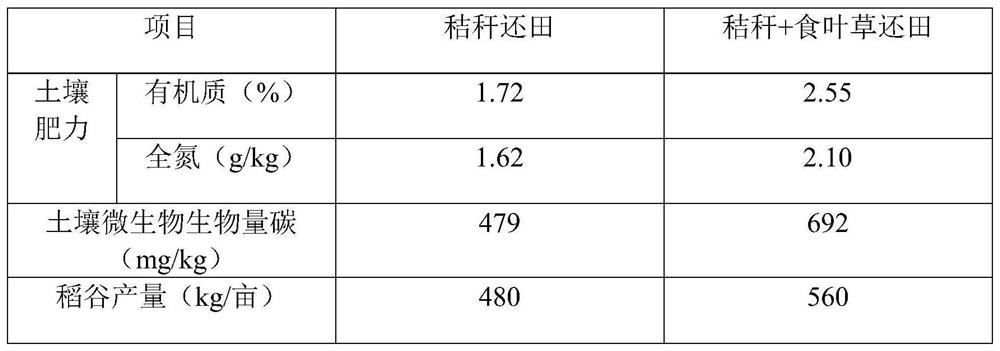Straw decay promoting method
A technology of straw and leaf-eating grass, which is applied in the field of efficient resource utilization of crop straw, can solve the problems of harsh cultivation conditions of bacteria agents, difficulty in large-scale promotion and use, and excessive use of nitrogen-containing compounds.
- Summary
- Abstract
- Description
- Claims
- Application Information
AI Technical Summary
Problems solved by technology
Method used
Image
Examples
Embodiment 1
[0023] Embodiment 1: a kind of straw rotting method, such as figure 1 shown, including the following steps:
[0024] S1: Mechanized harvesting after the rice is mature, crushing the straw to 10-15 cm, and throwing it on the ground;
[0025] S2. Cut the leaf-eating grass to a width of 0.5 cm-3 cm, and spread it evenly on the ground;
[0026] S3, turn over the ground, just turn over the straw and leaf-eating grass to cover the soil;
[0027] S4, release water after 24 hours to 48 hours of flooding, and keep the soil moist for 10 days.
[0028] In the S1-S2, the straw organic matter is 89.5% (carbon is 34.61%), leaf-eating grass protein is 32.3% (nitrogen is 5.168%), and the amount of straw per mu is calculated as 0.6 tons based on 0.5 tons of rice and 1:1.2 ratio of rice to grass (dry basis), calculated according to the carbon-nitrogen ratio of 25:1, then add 290 kg of leaf-eating grass (dry basis) per mu, and calculate according to 80% moisture, then add about 1.5 tons / mu of...
Embodiment 2
[0031] Embodiment 2: a kind of straw rotting method, such as figure 2 shown, including the following steps:
[0032] S1: Mechanized harvesting is carried out after the rice is mature, and the straw is broken to 10-15 cm by the harvester and scattered on the ground;
[0033] S2. Cut the leaf-eating grass to a width of 0.5 cm-3 cm, and spread it evenly on the ground;
[0034] S3. Use a tractor to plow the ground, and turn over the straw and leaf-eating grass to cover the soil;
[0035] S4, release water after 24 hours to 48 hours of flooding, and keep the soil moist for 15 days.
[0036] In the S1-S2, the straw organic matter is 92% (carbon is 35.58%), leaf-eating grass protein is 33.6% (nitrogen is 5.376%), and the amount of straw per mu is calculated as 0.5 tons of rice and the ratio of rice to grass is 1:1.2 is 0.6 tons (dry basis), calculated according to the carbon-to-nitrogen ratio of 30:1, then add 136 kg of leaf-eating grass (dry basis) per mu, and calculate accordin...
Embodiment 3
[0039] Embodiment 3: a kind of straw rot promoting method, such as image 3 shown, including the following steps:
[0040] S1: Mechanized harvesting is carried out after the rice is mature, and the straw is broken to 10-15 cm by the harvester and scattered on the ground;
[0041] S2. Cut the leaf-eating grass to a width of 0.5 cm-3 cm, and spread it evenly on the ground;
[0042] S3. Use a tractor to plow the ground, and turn over the straw and leaf-eating grass to cover the soil;
[0043] S4, release water after flooding for 24-48 hours, and keep the soil moist for 12 days.
[0044] In the S1-S2, the straw organic matter is 87.2% (carbon is 33.72%), leaf-eating grass protein is 32% (nitrogen is 5.12%), and the amount of straw per mu is calculated as 0.5 tons of rice and the ratio of rice to grass is 1:1.2 is 0.6 tons (dry basis), based on the carbon-to-nitrogen ratio of 20:1, the addition of leaf-eating grass (dry basis) per acre is: 560 kg, calculated on the basis of 80% ...
PUM
 Login to View More
Login to View More Abstract
Description
Claims
Application Information
 Login to View More
Login to View More - R&D
- Intellectual Property
- Life Sciences
- Materials
- Tech Scout
- Unparalleled Data Quality
- Higher Quality Content
- 60% Fewer Hallucinations
Browse by: Latest US Patents, China's latest patents, Technical Efficacy Thesaurus, Application Domain, Technology Topic, Popular Technical Reports.
© 2025 PatSnap. All rights reserved.Legal|Privacy policy|Modern Slavery Act Transparency Statement|Sitemap|About US| Contact US: help@patsnap.com



